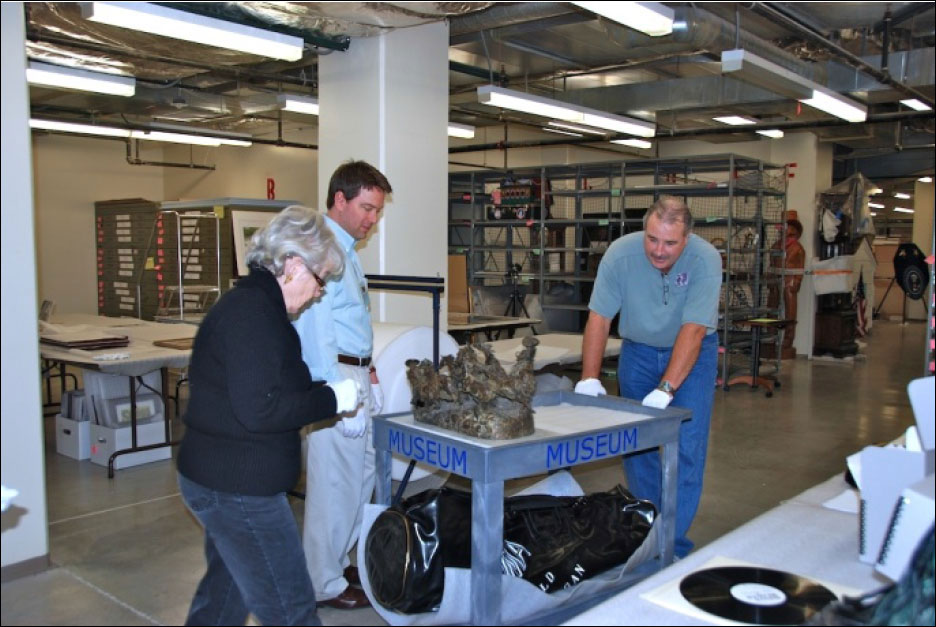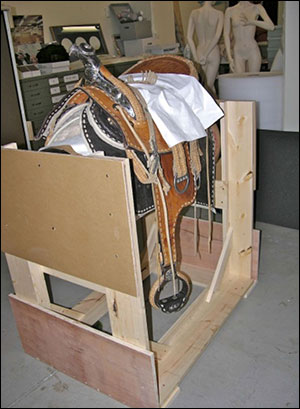
Technical Guidelines
What are our requirements for fire safety and security?
The borrower must house and display items from the National Archives and Records Administration (NARA) within a secure space in a fire-resistant building that meets NARA standards for security, fire protection. In addition:
- 24 hour fire detection and security systems must be connected to a central monitoring station.
- Fire suppression systems are required in storage, preparation, and exhibition areas.
NARA holdings must be exhibited in secure casework within dedicated galleries or other spaces meeting NARA standards.
When we evaluate proposals, we will assess any needs for special protective measures (for example- alarms and camera in exhibit cases,silica gel inside a case to control relative humidity or a maintenance plan to exhibit sculpture outdoors).
A facility under construction or renovation may require special scrutiny to ensure the safety and protection of our holdings. NARA may recommend the use of special protective measures such as dust barriers, burn permits, fire watches, and temporary environmental control.
Minimum-security requirements:
- A trained security guard or other trained personnel must patrol the exhibition area during public hours.
- Borrowers must take appropriate measures to prevent visitors from touching NARA holdings. Documents and other small items must be exhibited inside locked cases or with a secure wall-hanging system with glass, acrylic, or other appropriate glazing.
- Security, case design and other enclosures must not inhibit prompt access by borrower's staff if items need to be removed during an emergency or for other authorized access.
- For items displayed outside of an exhibition case, NARA requires a perimeter alarm or pressure alarms reporting to a 24-hour manned central monitoring location, constant guard presence, or other comparable measures.
Site visits may be required at the borrower's expense before the loan.
The borrower must have up-to-date emergency response-and-disaster recovery plans.
Eating, drinking, and smoking must be prohibited in the storage, preparation, and exhibition areas.
Additional requirements may be necessary for high-security items, including guard service, alarms, cameras, etc., 24 hours a day, seven day a week, or to remedy any non-compliance with NARA's exhibit standards.
What are NARA's environmental control requirements?
The borrower must monitor and control temperature, relative humidity, particulates, and gaseous pollutants in the storage, preparation, and exhibition areas to comply with NARA standards or as outlined in the exhibition loan agreement. Unless specified otherwise in the loan agreement:
- Maintain temperature between 65 and 75 degrees Fahrenheit with fluctuations of no more than 5 degrees during any 24-hour period. Confer with your NARA point of contact to establish set points.
- Maintain relative humidity at a set point between 35 and 50 percent plus or minus 5 percent with fluctuations of no more than 5 percent in a 24-hour period. Confer with your NARA point of contact to establish set points.
- Protect holdings from particulate and gaseous pollutants through air filtration of the space and/ or enclosure in a sealed enclosure.
- Maintain required environmental conditions 24 hours a day, 365 days a year.
- Depending on the items and conditions in the exhibition space, NARA may specify more stringent controls Specially designed casework may be required to provide a suitable microclimate, and monitoring devices may be required within the casework.
Lighting
What are the lighting requirements for exhibiting original NARA holdings?
NARA will specify in the loan agreement both the length of exhibition and the allowable levels of visible light to which the items may be exposed. Required light levels will vary depending on condition of the item and its sensitivity to light. UV must be filtered to no more than 10 microwatts per lumen.
Natural light must be excluded from exhibition galleries. If natural light is present in space where light-sensitive items are to be exhibited (through windows, skylights or similar architectural features) use black-out curtains, scrims and filters, or other barriers or techniques to meet NARA's requirements.
Unless otherwise approved as part of the exhibition plan or exhibit loan agreement, limit light falling on NARA holdings to 10 hours of exposure time per day, including time for housekeeping. Shorter durations are preferred. Turn off casework lighting and track lighting during non-public hours. We recommend a separate low-intensity maintenance lighting system for cleaning and security.
What lighting fixtures are most appropriate to protect light-sensitive holdings from light damage?
The preferred method to illuminate archival documents and artifacts is gallery lighting outside the exhibit casework housing. If interior case lighting must be used, please follow these requirements:
- Fiber optic lighting with ultraviolet filtering at the light source or light emitting diodes (LED) that exclude ultraviolet radiation are preferred.
- Any lighting systems used inside casework, including the illumination source for fiber-optic systems, must be in a separately ventilated compartment.
- Fluorescent lighting inside the case should be at least 24 inches from any original document or artifact and must include ultraviolet filters on the light sources.
- Do not use incandescent or halogen lighting inside exhibit cases. Such lighting must be located at least 36 inches from the displayed items.
What construction materials and finishes may be used in close proximity to the documents and artifacts?
Construction materials and finishes used throughout the galleries and in case construction must be chemically stable and physically non-damaging to holdings. NARA must approve materials specifications, the design and construction of new or renovated exhibit casework in advance of the proposed exhibition of NARA holdings.
- NARA must approve materials used to construct and finish any permanent and temporary exhibition cases in which original holdings will be exhibited.
- NARA reserves the right to review or test exhibit case materials or request that the borrower test materials.
The use of exposed wood is not permitted in the exhibit chamber where holdings are on view. . NARA avoids the use of wood or wood products in exhibit and desiccant chambers in favor of aluminum panels, acid-free paper honeycomb panels, high-density polyethylene, aluminum/polyethylene laminates, high-pressure density laminates (HPDL), glass, and stable plastic sheets. Any wood used within the exhibit chamber must be isolated using a NARA-approved method, such as use of a HDPL, vapor barrier laminate or foil.
For certain items, NARA may require incorporation of a pollutant scavenger and passive pollutant monitor inside the exhibit casework.
Packing and shipping
What are NARA's packing and shipping policies and procedures?
Our Outgoing Loan Agreement will specify packing and shipping arrangements. NARA will determine methods based on the condition, fragility, size, and value of items.
Small, high-value items must be hand-carried by NARA staff at the borrower's expense.
If an item is transported by air and the package will not fit underneath the seat, the borrower may be required to pay for a second seat to hold the package in transit.
Items that are too large to be hand-carried may be crated and transported by a fine arts shipper or other appropriate means. Items of sufficiently high monetary or historical value may require a NARA courier to accompany them.
Couriers transporting high-security items may be required to travel business class or first class for security purposes and may require a security escort.
Courier and shipping arrangements, including methods, personnel and dates, are to remain strictly confidential for security purposes.
Conservation Guidance
Who is authorized to handle and prepare NARA holdings?
The borrower may not alter, clean, repair, or treat loaned items or remove them from polyester encapsulations, acrylic packages, mats or frames without NARA's express written consent.
Borrowed items must be handled only by museum, archival, or library professionals on the borrowing institution's staff, their accredited representatives, or NARA staff.
NARA may restrict handling of holdings that are deemed to be especially fragile and vulnerable holdings to NARA staff.
Where can I find more information about exhibiting archival and museum items?
NARA Conservation personnel are available to provide guidance on conservation requirements for exhibition cases, frames, mounting methods, light levels, materials testing, etc. For additional guidance, see the National Information Standards Organization's Environmental Conditions for Exhibiting Library and Archival Materials, the National Park Service's Exhibit Conservation Guidelines, and American Alliance of Museums' Museum Registration Methods 6th Edition. NARA reserves the right to specify its own requirements for its holdings.
What are NARA's insurance requirements?
The borrower must insure loan items under an all-risk, wall-to-wall fine arts policy. Before the items leave NARA, a certificate of insurance must be on file. NARA must be named a beneficiary or an additional insured on the borrower's policy. NARA will assign values on the Outgoing Loan Agreement. Valuations are confidential.
What types of costs are associated with loans?
All loan-related costs are the responsibility of the borrower, including but not limited to: site inspections, packing and shipping, photography, conservation, insurance, courier travel and related expenses, and matting, framing, mounts, or book cradles. NARA does not charge loan fees.
What law would be applicable in disputes among borrower and lender?
U.S. Federal law governs all loan agreements for all purposes, including, but not limited to, determining their validity, the meaning of provisions, and the rights, obligations and remedies of the parties to the agreement. In the event that Federal law does not apply to a particular question or matter, the parties to the agreement will decide what state law will govern.



